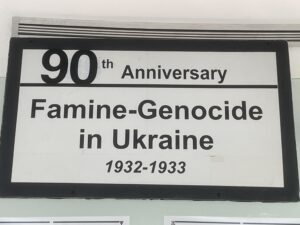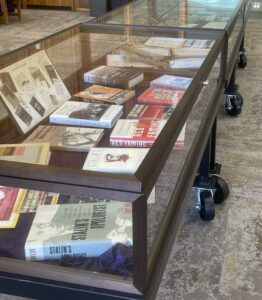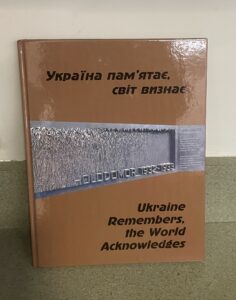Library users in Douglass are accustomed to viewing an array of diverse presentations – from fun, stressbuster-type displays to informative, thought-provoking exhibits. This fall’s “catwalk” gallery featuring the t-shirts of Clothesline Project to combat gender violence and Banned Books Week miniposters created by students during their SEBS Academic Mentoring library sessions are still in the computer lab area.
 From November 10 through December 2023, Douglass Library is hosting the Holodomor Exhibit in the Rotunda and in the Mabel Smith Douglass Room, curated by the Ukrainian National Women’s League of America (UNWLA). Along with a movie screening of Mr. Jones, based on the story of the first journalist’s struggles to report on the Holodomor, and a talk by Victor Rud, JD, “Moscow’s Starvation of Ukraine (1932-1933) – Why, How, and So What?” on Monday, December 4 at 4:00 pm, this exhibit commemorates the 90th anniversary of the Holodomor, the Great Ukrainian famine in the 1930s, with facts, images, and books on display.
From November 10 through December 2023, Douglass Library is hosting the Holodomor Exhibit in the Rotunda and in the Mabel Smith Douglass Room, curated by the Ukrainian National Women’s League of America (UNWLA). Along with a movie screening of Mr. Jones, based on the story of the first journalist’s struggles to report on the Holodomor, and a talk by Victor Rud, JD, “Moscow’s Starvation of Ukraine (1932-1933) – Why, How, and So What?” on Monday, December 4 at 4:00 pm, this exhibit commemorates the 90th anniversary of the Holodomor, the Great Ukrainian famine in the 1930s, with facts, images, and books on display.
True to UNWLA’s mission, the 78 posters in the Rotunda aim to advocate and educate the public about Ukraine then and now. The three display cabinets in the Mabel Smith Douglass Room present further information, such as news coverage, related scholarly books, and resolutions to recognize the Holodomor as genocide. If you are unable to visit in person, view some of the exhibit in the online gallery.

Maria Flynn of the UNWLA is setting up the display in the Mabel Smith Douglass Room: dried wheat on a handmade cross stitch tablecloth serves as the backdrop.
I had the opportunity to talk to the curators of the exhibit, as their small, enthusiastic team (led by Maria Flynn of the UNLWA and including Rutgers students representing the Rutgers Ukrainian Students Club) was setting up the exhibit.
As Maria Flynn explained:
In 1932-33, Stalin imposed his genocidal-famine against the Ukrainian people to punish independent-minded Ukrainians for their resistance to Stalin’s political, economic, cultural, and social subjugation. He first targeted the intelligentsia by executing them or deporting them to the Gulag. Next, he targeted the farmers who resisted giving up their farms to the state-owned collectivized farms. His weapon was food. He starved as many as seven million people. His intent was to destroy Ukraine’s national identify. Today, the Ukrainian people are again facing the threat of genocide as a result of Putin’s military invasion of their homeland. Genocidal acts have already been committed in many towns including the deportation of Ukrainian children to Russia. Putin’s intent as well is to destroy Ukraine’s national identity. The 90th anniversary of the Holodomor allows us recommit ourselves to reflect upon the heinous crimes of totalitarian regimes so that we may one day eliminate tyranny from our world.

The Holodomor exhibit in the Rotunda in Douglass Library. Click image to see some images online.
Holodomor Q&A
As a former professor of Hungarian Studies (1999-2003) at Rutgers, who was born and raised in Hungary, I have a general idea of unawareness related to cruelty and inhumanity of dictatorships in the Soviet Union and Eastern Europe. The Holodomor is no exception. Below are a few questions that I encountered while preparing to share the posters and displays online. The brief answers are meant to inspire the reader to look up more details in the exhibit panels and Rutgers University Libraries.
What does the word “Holodomor” mean?
The literal translation means “murder by starvation,” from Ukrainian holod, ‘hunger’, and moryty, ‘to exterminate.’
What is the Holodomor?
The Holodomor refers to the the Great Ukrainian famine in the 1932-33, which was a part of the deliberate mass starvation in the grain-growing regions of Soviet Union during the totalitarian dictatorship of Joseph Stalin.
Who was Stalin?
Soviet dictator Joseph Stalin ruled the Soviet Union as secretary-general of the Communist Party of the Soviet Union (1922–53) and premier of the Soviet Union (1941–53) with “greater political power than any other figure in history” (Britannica). A brutal leader, he transformed the Soviet Union into a military superpower via forced government control over the economy and the collectivization of agricultural, executed with terror, executions, and exiles to labor camps, such as the Gulag. Building a cult around himself, he ruled by terror, strengthening his authority by granting superpower to the secret police and eliminating perceived enemies of the Soviet Union.

Books in the Mabel Smith Douglass Room. Click image to see them online.
What were the causes of the Holodomor?
A leader of the totalitarian dictatorship, Stalin felt threatened by the Ukrainians’ history of resistance to the Soviet Union and potential initiatives to fight for independence for Ukraine. To consolidate his power, he introduced mass repressions to arrest, imprison, exile, or execute Ukrainian intellectuals and pro-Ukrainian Communist Party members simultaneously with his collectivization of agriculture initiative. It resulted in the Stalin government’s full control over Ukraine, the “breadbasket of Europe.”
What was the purpose of collectivization?
The Communist policy of collectivization allowed the governments in Communist countries to expropriate privately owned land, no matter how small or big. Farmers with larger farms were labeled as Kulaks. They were forced, frequently via beating, to surrender their lands and properties and join Kolkhozes, the state-controlled farms, owned and governed by the collective in name only.
How did the collective farms work?
Machines, tools, livestock, and everything else farmers owned had to be “voluntarily” surrendered to the collective, which then was expected to meet unreasonable quotas, including grain quotas. All privately produced foodstuff was confiscated. People who tried to hide food were executed, as grain was considered state property, withholding was considered stealing, which warranted the death penalty.
What happened to those who refused to give up their land?
Anyone who resisted was exiled to labor camps, such as the Gulag, or executed.
What happened to the crops?
Crops were collected or confiscated by the collective and then sold throughout the Soviet Union and abroad. At the same time, the communist regime intentionally starved Ukraine’s farmers and their families, prohibiting them to travel to seek food in the cities.
What were the consequences and concerns?
Death from starvation, mass malnutrition, cannibalism, necrophagy, see exhibit panels for details. For more context, read also Chapter 1 – “The Soviet Famines” in Tymothy Snyder’s Bloodlands : Europe between Hitler and Stalin.
How many people died?
The end result was the death of millions of men, women, and children, with estimates by scholars ranging from 3.5 million to 7 million (with some estimates going even higher). According to recent demographic studies, 13.3 percent of Ukraine’s population died at the time of the Holodomor. At its height in June 1933, the Holodomor claimed the lives of 28,000 people EACH DAY.
Where was the international relief?
Despite the crisis, Soviet authorities denied the famine’s existence, tried to hide the scale of the damage, and refused foreign aid, as so many other times in history.
Is Holodomor considered a genocide?
According to the United Nations Genocide Convention, the term genocide, coined by Raphael Lemkin is “a crime committed with the intent to destroy a national, ethnic, racial or religious group, in whole or in part.” The classic example of Soviet genocide, the Holodomor received worldwide recognition as genocide. Most recently, on October 13, 2023, it was recognized as such by PACE (Parliamentary Assembly of the Council of Europe). Thirty-five countries since have recognized the Holodomor as genocide.
Did students learn about the Holodomor at school in neighboring countries?
Countries bordering the Soviet Union, such as Poland, Czechoslovakia, Hungary, and Romania, were the so-called bloc countries, also under Communist dictatorship. As such, it was unimaginable to learn about it. As of 2009, Ukrainian schoolchildren take a more extensive course of the history of the Holodomor. The Soviet Union forbade the study of the Holodomor. As far as they were concerned, “there was no famine.” People were afraid to even speak or mention the famine in fear of being persecuted. Since Ukraine’s independence in 1991, Ukrainian schoolchildren were finally exposed to the history of the Holodomor and the truth.
When is the Holodomor observed?
Since 1998, Ukraine has officially observed the Holodomor Memorial Day on the fourth Saturday of November.
Is there a memorial in the United States?
The Holodomor Memorial can be found in Washington, DC., close to the Capitol Building, pictured on the cover of the bilingual book shown to the right, Ukraine Remembers, the World Acknowledges.
Where are the documents about the Holodomor now?
Documentation of the Holodomor and other injustices are held in the Ukrainian National Museum of Holodomor Genocide in Kyiv, a state museum that preserves the memory of Holodomor victims and highlights the history of the genocide of the Ukrainian nation in 1932-1933. The museum is a center of commemoration of millions of Ukrainians killed during the Holodomor.
Do you have other posts related to Ukraine on this site?
Yes, we do. Feel free to browse our related content, you will find a two-page list of posts. A few examples:
- Books We Read About Ukraine
- InfoLit 101: The War in Ukraine on Social Media
- Arms and Muses: Poets from Ukraine
- Arms and Muses: Poems from Ukraine
Related Galleries
Related Titles from Rutgers University Libraries
- Borysenko, V. K. (2010). A candle in remembrance: an oral history of the Ukrainian genocide of 1932-1933. Ukrainian National Women’s League of America.
- Graziosi, A., Hajda, Lubomyr., & Hryn, Halyna. (2013). After the Holodomor : the enduring impact of the great famine on Ukraine.
- Hryn, Halyna. (2008). Hunger by design : the Great Ukrainian famine and its Soviet context. Ukrainian Research Institute, Harvard University.
- Holland, A., Norton, J., Mawle, J., Sarsgaard, P., & Kirby, V. (2020). Mr. Jones. Samuel Goldwyn Films.
- Hunczak, T., & Serbyn, Roman. (2007). Famine in Ukraine 1932-1933: genocide by other means. Shevchenko Scientific Society. Ukrainian Research Institute, Harvard University.
- Klid, Bohdan., & Motyl, A. J. (2012). The Holodomor reader: a sourcebook on the Famine of 1932-1933 in Ukraine. CIUS Press.
- Naimark, N. M., & Naimark, N. M. (2010). Stalin’s genocides (1st ed., Vol. 8). Princeton University Press.
- Noack, C., Janssen, L., & Comerford, V. (Eds.). (2012). Holodomor and Gorta Mór : histories, memories, and representations of famine in Ukraine and Ireland. Anthem Press.
- Snyder, T. (2010). Bloodlands: Europe between Hitler and Stalin. Basic Books.
Related Resources
- Holodomor Resource Library (Curated by experts, it’s a regularly updated source for authoritative and educationally sound English language materials about the Holodomor. Includes facts and history, eyewitness accounts, scholarly communications, recommended resources for teachers, and news)
- Selected Resources on the Holodomor (A downloadable, curated list of resources, created by Jana Babij, MLIS)
- Holodomor’s 90th Anniversary (Website of an anti-genocide campaign to raise awareness for an commemorate the 90th anniversary of the Holodomor)
- Holodomor Museum (Kyiv, Ukraine – website in English)
- Holodomor Basic Facts (From the Holodomor Research and Education Consortium, Canadian Institute of Ukrainian Studies, University of Alberta)
- UNWLA Toolkit (Includes book recommendations and more to host exhibits and event)
- Timothy Snyder: Ukrainian History as World History 1917-2017 (Video, 1:30:42): Keynote Speech at the “Revolutionary Ukraine: A Reflection on 1917 and Its Aftermath” Conference – Recorded on October 13, 2017 at the Institute for Human Sciences Library.
- Holodomor Research and Education Consortium – HREC (Online Holodomor Photo Directory)
- Ucrainica Research Institute (Provides more information about how the “Exhibit in a Box” was created)
